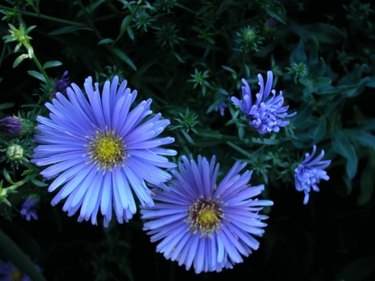Things You'll Need
Fertilizer
Fungal spray

Blooming in nearly every color, aster brighten up late summer and fall gardens. These perennial flowers return each year to bloom again. The color and shape of the flower depends on the variety of aster, with some producing flat daisy-like blooms and others forming full multi-petaled blossoms. Asters have a natural long blooming period, but good care both before and after flowering begins can extend the bloom time until the first frost in fall.
Step 1
Plant a variety of aster types. Combine summer, late summer and fall blooming aster varieties in the same bed for a longer bloom period. As the earlier blooming varieties begin to fade, the later flowering types will be hitting their peak bloom time.
Video of the Day
Step 2
Fertilize the asters in early summer with ½ cup of 5-10-10 fertilizer per every 50 square feet of garden bed. Sprinkle the fertilizer on the soil surface around the plants and water thoroughly. A low-nitrogen, phosphorus fertilizer early in the season encourage bud formation and flowering.
Step 3
Water the asters before and during bloom deeply once a week. Water the soil at the base of the flowers until the soil is moist to a 6 inch depth, but avoid overhead watering that wets the foliage.
Step 4
Apply a powdery mildew spray beginning in early July until the end of the growing season in fall, following label application instructions. Asters are prone to powdery mildew, a fungal growth that begins on the leaves and weakens the plant. Weak plants may flower poorly.
Step 5
Deadhead asters once the flowers begin to wilt. Pinch off the dead flower, leaving the stem and any remaining flower buds intact. Dead flower removal prevents seed formation and encourages a new set of flowers on some aster varieties. Some asters, like Frikart's Aster, produce small buds directly beneath the old flower head so take care not to damage these buds when you are deadheading.
Tip
Cut back asters to half their height in late June to encourage fuller plants with more flowers, Cut back asters may begin flowering later than those that aren't cut back.
If your perennial asters are blooming poorly or for only a short time, dig up the roots and divide the plants. Asters become overcrowded and require division every three years.
Video of the Day